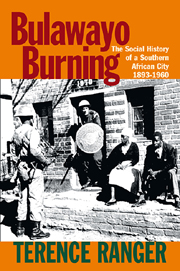Book contents
- Frontmatter
- Contents
- List of Illustrations
- Introduction
- Prelude: Bulawayo, 1893–1930
- 1 The Landscapes of Bulawayo
- 2 The First Fires: December 1929
- 3 City versus State 1930–1946
- 4 Mr Black Bulawayo 1930–1948
- 5 The Feminization of Black Bulawayo 1948–1960
- 6 Black Bulawayo Transformed
- 7 Black Bulawayo Burns 1960
- Postlude: Bulawayo after 1960
- Selected Bibliography
- Index
5 - The Feminization of Black Bulawayo 1948–1960
Published online by Cambridge University Press: 05 April 2013
- Frontmatter
- Contents
- List of Illustrations
- Introduction
- Prelude: Bulawayo, 1893–1930
- 1 The Landscapes of Bulawayo
- 2 The First Fires: December 1929
- 3 City versus State 1930–1946
- 4 Mr Black Bulawayo 1930–1948
- 5 The Feminization of Black Bulawayo 1948–1960
- 6 Black Bulawayo Transformed
- 7 Black Bulawayo Burns 1960
- Postlude: Bulawayo after 1960
- Selected Bibliography
- Index
Summary
Transition, 1948–1953
The 1948 strike changed everything in Bulawayo but it did not change it all at once. Donald Macintyre continued to dominate the City Council. Sipambaniso continued to be the big man in Makokoba. But by 1953 both had gone from the political life of Bulawayo. Sipambaniso died in 1952 and in 1953 Macintyre became Federal Minister of Finance, continuing to live in west Bulawayo but no longer controlling municipal policy. They were replaced, as we shall see, by other black and white leaders, who played out the drama of the 1950s. But first we must narrate the humbling of Macintyre and the waning of Sipambaniso.
The Humbling of Macintyre
When the black Bulawayo workers went on strike in favour of the government and against Macintyre he could no longer maintain his stance as a socialist. In mid-1948 he resigned as leader of the Southern Rhodesia Labour Party and joined Huggins's United Party. He retained his seat in parliament at the next election as a government candidate. In parliament he had to abandon his feud with Huggins and his opposition to the Native (Urban Areas) Accommodation and Registration Act, but in Bulawayo he did what he could to delay and impede its implementation.
- Type
- Chapter
- Information
- Bulawayo BurningThe Social History of a Southern African City, 1893–1960, pp. 167 - 184Publisher: Boydell & BrewerPrint publication year: 2010



